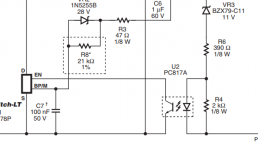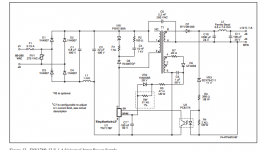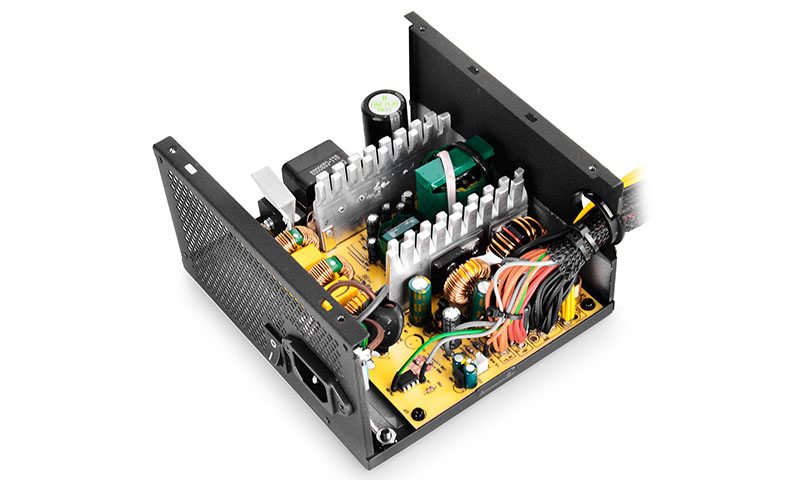If what you say was actually true I'd be dead long ago. Death is POSSIBLE, not GUARANTEED.Well, you *should*
Voltage is never absolute but relative to another point.
* If you touch (accidentally or on purpose) the "+380V" node with a fingertip (or elbow or wrist or any other body part) but nothing else in that supply, specially its chassis or supply ground, nothing happens.
* if you touch *any* point in the *hot/live* side of that supply, you die , for the very good reason that already, always, you are touching "another point" : ground/earth/the floor.
You think both situations are the same?
If you are "tinkering" with the secondary side, you are handling/touching/holding one way or another a single board, palm sized, where you will be soldering/desoldering/modding on the admittelly safe secondary, 1 inch away from half the board which is live/hot.
The potential for error is there.
No need to connect secondary to primary, fully exposed hot parts are there at your fingertips.
You are comparing apples to oranges.
Standard power supplies are:
1) very simple, you only have to pay attention to power switch contacts, fuse ones, and little else, and they are "all together" on a separate, easy to avoid place, wires carrying mains voltage into the transformer are insulated, while *all* components and tracks on an SMPS primary side are hot and exposed.
2) when building an amplifier, mains wiring is made with everything unplugged and never touched again, while when tinkering with the board as needed here, you are handling and touching it and to adjust it must be on.
Again:
You think both situations are the same?
Adjust it, power it, test it, unplug it, wait for the caps to discharge, adjust and test again.
Also when working with high voltages smart people keep one hand in their pocket or behind their back. Getting a 500V shock across a finger tip sucks but it won't kill you, having that same current go through your body across your chest can easily kill you.
BTW I measured only 330VDC in the ATX (momentarily powered, no load), not 380V. Furthermore you certainly DO feel it if you brush the HV even without touching anything else. It's just nowhere as bad.
In any case I was hoping it might be as simple as adding a diode between the regulation and ground to "lift" it .7V like you can with a 7812...
In any case it seems as it's more complex than that, and I can live with 12V.
This 12V SMPS powers 20 tube heaters and two boost inverters... One that outputs 380VAC at 20kHz, and one that outputs 280VDC. The AC is rectified with HER208 and fed to the plate circuit of a class A push pull 6550 amp. The 280V is used for the line/driver/headphone and buffer stages. I'm thrilled with it's performance. It's stiff, efficient, smaller and cheaper than a linear supply with similar ratings... Plus it's hard to find a transformer that outputs 12V@20A, and 350-250-0-250-350@1A This entire power supply cost me less than $100 to build. My rough math suggests the linear version would cost over $300.
Last edited:
why not post the schematic of your target psu so we can see what can be done,
the pwm chip, what is the part number?
there is the ka7500, TL494, UC3852 etc...
http://www.ti.com/lit/ds/symlink/tl494.pdf
http://www.ti.com/lit/ds/symlink/uc2852.pdf
the pwm chip, what is the part number?
there is the ka7500, TL494, UC3852 etc...
http://www.ti.com/lit/ds/symlink/tl494.pdf
http://www.ti.com/lit/ds/symlink/uc2852.pdf
Take care with the hot side of a switching PSU.
There can be a lot of energy stored in the caps. The residual current breaker on your bench isn't going to stop that hurting.
If the OP wants more than his PC supply will give, step up switchers are available on ebay for the price of a beer. But I'm sure many attics still contain PC supplies where loading the 5V will boost the 12V a little. Or you can buy a 15V smps for the price of two beers.
There is no "residual current breaker" on my bench. The North American electrical system is hub and spoke, not ring, so in my case I have fuses in a fusebox in the closet for all the circuits in the house. Agreed though 15A won't save you from a shock, however "mains" is much less dangerous here simply because we use 120V 15A branch circuits.
An old PC supply is only 200W-300W, and then mostly 5V and 3.3V whereas this one is 700W and claims to be able to put out 55A@12V
Either the 15V supply for the price of two beers is an underpowered piece of junk or beer is bloody expensive where you are
that is a chopper type pwm circuit,
output voltage controled by feedback from an opto isolator,
so my guess is lowering the value of the opto diode shunt resistor will increase output voltage, perhaps at 20k ten turn bourns trimpot can be used here to vary the voltage,
go slow.....stay safe.....
quick question, what is the brand and make of atx psu you are using?
can you post the label of that psu so we can get more info?
output voltage controled by feedback from an opto isolator,
so my guess is lowering the value of the opto diode shunt resistor will increase output voltage, perhaps at 20k ten turn bourns trimpot can be used here to vary the voltage,
go slow.....stay safe.....
quick question, what is the brand and make of atx psu you are using?
can you post the label of that psu so we can get more info?
Attachments
strange but this chip is low powered, perhaps this is for the 5 volt standby ckt to power USB devices and for starting the psu...
700 watts ATX require a double or even more mosfet choppers...
It's a Deepcool DA700. I can't find the same model even on their website... I can't see which mosfets is uses (it's a tight squeeze with 4 devices on one sink, and 5 on the other facing inwards. And there are 3 4 pin DIP chips which I can't read the writing (it's tiny).
I'll just leave it alone since it is working. 6V is still in spec for the heaters anyway.
Thanks for your assistance though.
I'll just leave it alone since it is working. 6V is still in spec for the heaters anyway.
Thanks for your assistance though.
there are quite a number of brands, but there are not many OEM for atx psu,
there is pc and power cooling, then delta electronics and a few others...
i will bet that that atx has an active power factor correction circuit....

there is pc and power cooling, then delta electronics and a few others...
i will bet that that atx has an active power factor correction circuit....

An externally hosted image should be here but it was not working when we last tested it.
Beavis and Butthead also show tons of "attitude" , including: "look Mom!!! I got shocked repeated times!!!!! and I´m still alive!!!! ..... wait until I tell the other kids!!!!"
and I´m still alive!!!! ..... wait until I tell the other kids!!!!"
Do as you wish ... for yourselves .... just don´t drag others inside your grave If/When
Darwin just smiles and waits, he´s got all the time in the World
Do as you wish ... for yourselves .... just don´t drag others inside your grave If/When
Darwin just smiles and waits, he´s got all the time in the World
Beavis and Butthead also show tons of "attitude" , including: "look Mom!!! I got shocked repeated times!!!!!and I´m still alive!!!! ..... wait until I tell the other kids!!!!"
Do as you wish ... for yourselves .... just don´t drag others inside your grave If/When
Darwin just smiles and waits, he´s got all the time in the World
If you know about electricity, have respect for it, use appropriate PPE, and work on HV with a friend present etc the risk of shock is very low and the risk of death even lower still. If you are scared to work on low energy powered electrical devices your chance of making a mistake increases. Personally I only work live where I need to test voltages, I clip the ground lead and use one hand with the 1000V cat IV probe/meter. I do not recommend working on power distribution equipment while it's in service.
BTW most electrical deaths result from arc flash, not shock.
YouTube
Last edited:
I did some DC verses hum bucked AC and found the diffrence to be small. One thing to think about is the heater to cathode is a capacitor of sorts and some HF noise could get through from the SMPS. This is stated in most tube data as to pF.
One guy I read said he had a switch that changed heater pin polarity each time it fired up. In his veiw it reduced magnetic residual and no real cost.
As far as I know 12.6V was based on lead acid batteries and was +/- 10% ideally.
A set of motorcycle batteries and cheap charger might beat the SMPS. One could do the polarity switch in the same circuit. I dare say even if charging the hum would be OK. Pull it down with a lamp prior to use for a minute?
One guy I read said he had a switch that changed heater pin polarity each time it fired up. In his veiw it reduced magnetic residual and no real cost.
As far as I know 12.6V was based on lead acid batteries and was +/- 10% ideally.
A set of motorcycle batteries and cheap charger might beat the SMPS. One could do the polarity switch in the same circuit. I dare say even if charging the hum would be OK. Pull it down with a lamp prior to use for a minute?
The original DA700 (which was the cheapest supply on sale) died after my partner accidentally ran 2 tube amps into the same speakers for a period of time. The primary had a trace burn off and arc. I am now using a much better ATX supply (EVGA Supernova 750 G2, 10 year warranty, fanless up to 400W, 15mV ripple when 12V is loaded to 40A!). This time it's wired up to the power supply box by it's cables, thereby keeping the warranty intact. The new wiring also means I can test any other ATX with 8 pin EPS.
I have never heard hash though these amps, but once I used an unfiltered SMPS for the heaters in a preamp and found out I had a 43.7kHz oscillation. It was not shielded and was in the chassis with the rest of the preamp.
I have LEDs and relays running from the 12V, too, so I can't reverse the polarity.
I'm sure a car battery would have no ripple, but a fully charged 60Ah battery would only power this amp for less than 3 hours (Max power consumption is about 250W). I have thought about the possibility of building something tubed for the car, and this would work. but on the other hand what's the point with all the road noise anyway?
I have never heard hash though these amps, but once I used an unfiltered SMPS for the heaters in a preamp and found out I had a 43.7kHz oscillation. It was not shielded and was in the chassis with the rest of the preamp.
I have LEDs and relays running from the 12V, too, so I can't reverse the polarity.
I'm sure a car battery would have no ripple, but a fully charged 60Ah battery would only power this amp for less than 3 hours (Max power consumption is about 250W). I have thought about the possibility of building something tubed for the car, and this would work. but on the other hand what's the point with all the road noise anyway?
The idea was to have two batteries being charged in rotation. My SE amp will last longer due to only needing 3.6Amps. I have looked for my 3.15- 0 - 3.15 V tests against a very high grade bench PSU without sucess. There was virtually nothing in it. Resistor or capacitor hum bucking are other options. See Dynaco ST70 for the capacitor type. Building the quietest HT I could it was -88 db below 1 watt. The heater options were slightly lower. This was a SE amp which has about a 20 dB disadvantage over PP in my example. This idea both impressed and troubled me.
YouTube
I could believe PSU noise is not the big deal many think when using fast devices in class A. If all is > 50 kHz it could help!!!There was a theory put forward that a little bit of bias could make a transformer work better. I have no idea if true. The Hypex class D amp I measured puts out 400 kHz in buckets full. It sounds very good. It looks to roll off at about 47 kHz much like many tube amps. The Hypex output devices are similar to tubes in this respect.
You can use the existing PSU LED by inserting a standard lets say W08 or 4 x 1N4007 bridge rectifier before the LED, 4 x 1N4148 could work if only 12 V and <5 mA. Feed the 12V into the AC terminals. It will give about 10.8V at light load and always in the stated DC polarity.
The only reason I mention any of this is that a true 12V is most likely fine. There are two issues most never thinking of that might be more important. I would imagine a 0.1uF at heater number one could work as a simple RC filter. The small resistance of the wire enough to for a > 50 kHz. It is worth saying the op amp came into general use soon after it was invented due to not being happy with RF noise. It was useless for the military who thought up it's design ( why cut silicon up into transistors, make cities of them ). Tubes were prefered by the Russians or USSR as they worked perfectly well. Cathode magnetisation is thought to be a bad thing by some. Again I have no idea. It is worth reading up on all cathode problems. There are many. I could imagine having SRPP stages where the tubes are swapped periodically to have the opposite use of cathodes would have advatages, that's AC or DC heated. Cascodes also.
The Valve Wizard
YouTube
I could believe PSU noise is not the big deal many think when using fast devices in class A. If all is > 50 kHz it could help!!!There was a theory put forward that a little bit of bias could make a transformer work better. I have no idea if true. The Hypex class D amp I measured puts out 400 kHz in buckets full. It sounds very good. It looks to roll off at about 47 kHz much like many tube amps. The Hypex output devices are similar to tubes in this respect.
You can use the existing PSU LED by inserting a standard lets say W08 or 4 x 1N4007 bridge rectifier before the LED, 4 x 1N4148 could work if only 12 V and <5 mA. Feed the 12V into the AC terminals. It will give about 10.8V at light load and always in the stated DC polarity.
The only reason I mention any of this is that a true 12V is most likely fine. There are two issues most never thinking of that might be more important. I would imagine a 0.1uF at heater number one could work as a simple RC filter. The small resistance of the wire enough to for a > 50 kHz. It is worth saying the op amp came into general use soon after it was invented due to not being happy with RF noise. It was useless for the military who thought up it's design ( why cut silicon up into transistors, make cities of them ). Tubes were prefered by the Russians or USSR as they worked perfectly well. Cathode magnetisation is thought to be a bad thing by some. Again I have no idea. It is worth reading up on all cathode problems. There are many. I could imagine having SRPP stages where the tubes are swapped periodically to have the opposite use of cathodes would have advatages, that's AC or DC heated. Cascodes also.
The Valve Wizard
- Status
- This old topic is closed. If you want to reopen this topic, contact a moderator using the "Report Post" button.
- Home
- Amplifiers
- Power Supplies
- 12.6V from ATX instead of 12V? Any ideas?


